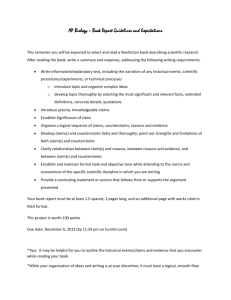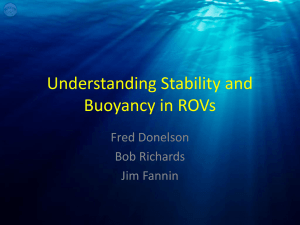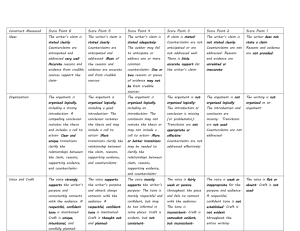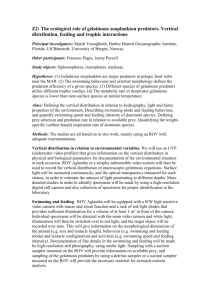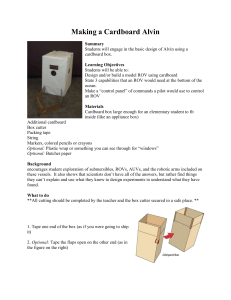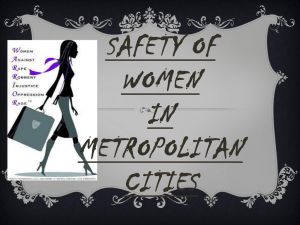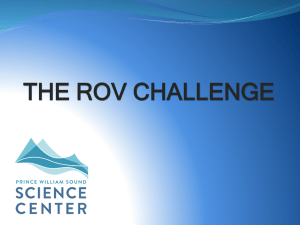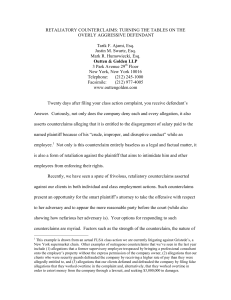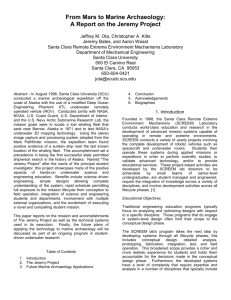Project Overview - Materials Research Laboratory at UCSB
advertisement
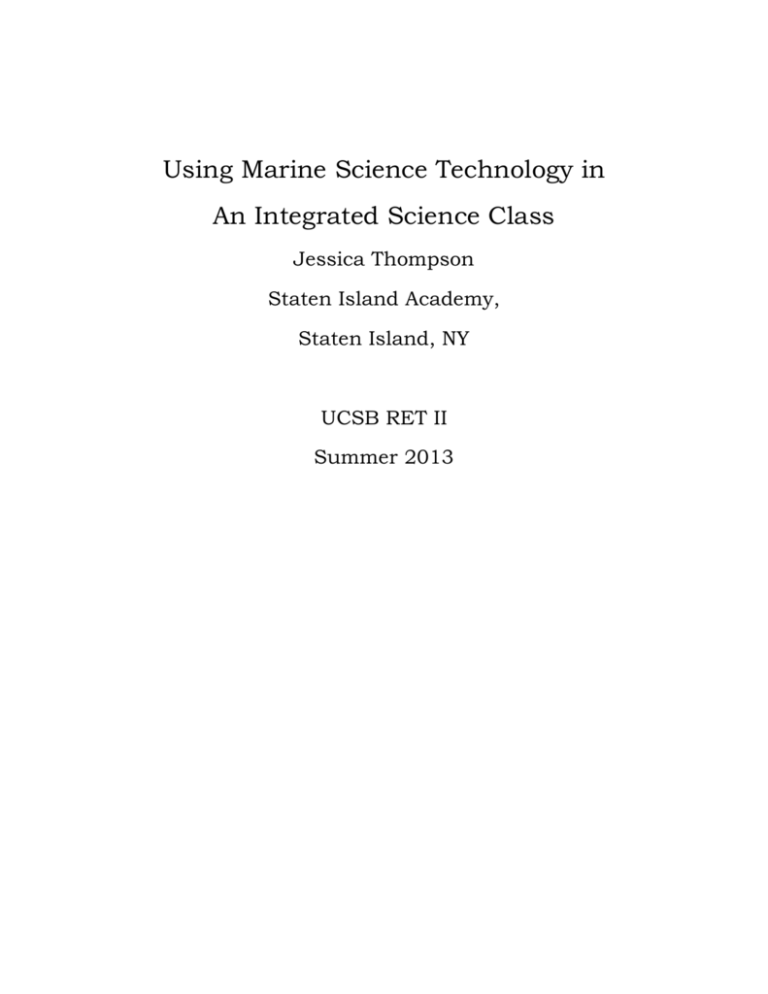
Using Marine Science Technology in An Integrated Science Class Jessica Thompson Staten Island Academy, Staten Island, NY UCSB RET II Summer 2013 Using Marine Science Technology in an Integrated Science Class Jessica Thompson RET2 Summer 2013 Table of Contents Project Overview Overview of Standards 1. Introduction to Density, Pressure, Depth relationships Lesson Plan and Timeline Power point slides “Things are Different Under Water” with teacher notes (digital) Exploration: “Under Pressure” activity teacher and student materials Student Handout: Characteristics of Fish in Major Ocean Zones (to accompany film Blue Planet: Deep Ocean) 2. Introduction to Undersea Technology Lesson Plan and Timeline Power Point slides: “History of Undersea Exploration” with teacher notes (digital) Activity: Designing Floats Teacher and Student material Exploration: Modeling the Trieste to Explore Density and Buoyant Force Reading Assignments: National Geographic articles James Cameron’s Deepsea Challenge (2 parts) Includes articles and response assignments 3. Build a Working Model of an ROV Lesson Plan and Timeline Purchase information for “ROV in a Bag” Kit from MATE From Scratch Construction Manual of ROV Seaperch by MIT Project: Design Your Own Submersible (Student handout and Teacher notes) 4. Extension: Using ManyLabs water sensors to Collect Ecological Data Preliminary activity: Investigating Dissolved Oxygen (Student handout and Teacher notes) ManyLabs purchasing information My Research Experience in RET I In the summer of 2012, I assisted PH.D. candidate Nadine R. Martinez Rodriguez of the Herbert Waite lab group at UCSB on a project to investigate the adhesive plaques of marine mussels. I was primarily working to determine whether the mussels’ adhesive proteins have antimicrobial properties. The mussel foot proteins (Mfps) were isolated using acid/urea polyacrylamide gel electrophoresis (AU-PAGE), size exclusion chromatography (SEC) and reverse phase HPLC (RP-HPLC). These methods purified the proteins down to Mfp-3 and Mfp-6 so that the antimicrobial action of each individual protein could be tested. We tested for the inhibition of growth of E.coli using radial diffusion assay. Preliminary results were minimal, but showed signs that Mfp- 3 and 6 do not inhibit growth of E. coli in radial diffusion assay. However, further tests using different assays and different microbes will be conducted. This experience refreshed and refined my lab skills. I was able to confidently bring new knowledge to my students about current high-level research and laboratory practices. RET 2: Curriculum Project Overview Abstract: This unit spans three to four weeks and connects under water physics principles such as density, pressure and buoyant force to the hands on activity of designing and operating under water craft. Students will explore and calculate pressure changes and buoyant force under water through a series of short experiments. Using the knowledge gained in these labs, students will build a model of the Trieste, the first bathyscaphe to reach the bottom of the Mariana Trench, in order to illustrate Archimedes’ Principle. They will then work as a team to construct a working model of a remote operated vehicle (ROV) based on the successful “SeaPerch” design from MIT. As a culminating activity students will design their own blueprint for a submersible. My future goal is to extend this engineering activity using a set of water sensors that can be deployed in the water with the ROV. Using the ROV with sensors attached to collect data such as dissolved oxygen in a local marine or aquatic environment can be done as an extension or final product if equipment is available. Students can then develop a research question and design an investigation using these variables in connection with the health of an ecosystem. Rationale and Context: It is my philosophy that science should be taught with integration in mind. Students must see that science in application is interdisciplinary, even though the disciplines are compartmentalized in school. In this unit, students incorporate concepts from physics and engineering into an investigation of the ecological health and chemistry of a local environment. This unit can be done in an integrated science class such as Oceanography or Environmental science or as collaboration among science teachers of different disciplines, such as physics and biology. Learning Objectives: Each element of the unit has its own learning objectives, but overall, each is intended to apply the principles of physics, technology and biological research in a meaningful and hands- on experience. A general objective is for students to use and improve problem solving and critical thinking skills. To this end, teachers are encouraged to structure the explorations in an inquiry style so that students may develop their own methods and solve problems while working toward a preestablished final goal of constructing and using the ROV. Depending on the availability of equipment such as sensors or an inexpensive underwater camera (see materials), this equipment can be attached to the ROV to collect data and samples. . Overview of Standards Next Generation Science Standards High School Motion and Stability: Forces and Interactions HS-PS2-6 Communicate scientific and technical information about why the molecular level structure is important in the functioning of designed materials. Units 2 and 3 HS-PS2-1 Analyze data to support the claim that Newton’s second law of motion describes the mathematical relationship among the net force on a macroscopic object, its mass, and its acceleration. Unit 1 and 2 Ecosystems: Interactions, Energy, and Dynamics HS-LS2-6 Evaluate claims, evidence, and reasoning that the complex interactions in ecosystems maintain relatively consistent numbers and types of organisms in stable conditions, but changing conditions may result in a new ecosystem. Unit 4 HS-LS2-7 Design, evaluate and refine a solution for reducing the impacts of human activities on the environment and biodiversity. Unit 4 Next Generation Standards: Middle school Engineering Design MS-ETS1-2 Evaluate competing design solutions using a systematic process to determine how well they meet the criteria and constraints of the problem Units 3 and 4 MS-ETS1-4 Develop a model to generate data for iterative testing and modification of a proposed object, tool, or process such that an optimal design can be achieved. Unit 2 and 3 California Content Standards: Grade 8: (2a,b,c,d,e) (6a) (8a,b,c,d) (9a,b,c) Unit 1 Grades 9-12: Chemistry (5g) (6a,c,d) Ecology (6 a,b,c,d,e,f,g) Unit 4 Investigation and Experimentation (1 a, b,c,d,f,g,j,k,l,m) All units Common Core Standards for Literacy in Science and Technical Subjects for grades 6-12 Grades 6-8 1. Write arguments focused on discipline-specific content. a. Introduce claim(s) about a topic or issue, acknowledge and distinguish the claim(s) from alternate or opposing claims, and organize the reasons and evidence logically. Units 3 and 4 b. Support claim(s) with logical reasoning and relevant, accurate data and evidence that demonstrate an understanding of the topic or text, using credible sources. Units 2,3 and 4 c. Use words, phrases, and clauses to create cohesion and clarify the relationships among claim(s), counterclaims, reasons, and evidence. All units d. Establish and maintain a formal style. Unit 4 e. Provide a concluding statement or section that follows from and supports the argument presented. Units 2 and 4 Grades 9-10 1. Write arguments focused on discipline-specific content. a. Introduce precise claim(s), distinguish the claim(s) from alternate or opposing claims, and create an organization that establishes clear relationships among the claim(s), counterclaims, reasons, and evidence. Units 2, 3, 4 b. Develop claim(s) and counterclaims fairly, supplying data and evidence for each while pointing out the strengths and limitations of both claim(s) and counterclaims in a discipline-appropriate form and in a manner that anticipates the audience’s knowledge level and concerns. Unit 4 c. Use words, phrases, and clauses to link the major sections of the text, create cohesion, and clarify the relationships between claim(s) and reasons, between reasons and evidence, and between claim(s) and counterclaims. Units 2 and 4 d. Establish and maintain a formal style and objective tone while attending to the norms and conventions of the discipline in which they are writing. Unit 4 e. Provide a concluding statement or section that follows from or supports the argument presented Units 2 and 4 Grades 11-12 1. Write arguments focused on discipline-specific content. a. Introduce precise, knowledgeable claim(s), establish the significance of the claim(s), distinguish the claim(s) from alternate or opposing claims, and create an organization that logically sequences the claim(s), counterclaims, reasons, and evidence. Unit 2, 3, 4 b. Develop claim(s) and counterclaims fairly and thoroughly, supplying the most relevant data and evidence for each while pointing out the strengths and limitations of both claim(s) and counterclaims in a discipline-appropriate form that anticipates the audience’s knowledge level, concerns, values, and possible biases. Unit 4 c. Use words, phrases, and clauses as well as varied syntax to link the major sections of the text, create cohesion, and clarify the relationships between claim(s) and reasons, between reasons and evidence, and between claim(s) and counterclaims. Unit 4 d. Establish and maintain a formal style and objective tone while attending to the norms and conventions of the discipline in which they are writing. Unit 4 e. Provide a concluding statement or section that follows from or supports the argument presents Unit 2 and 4
